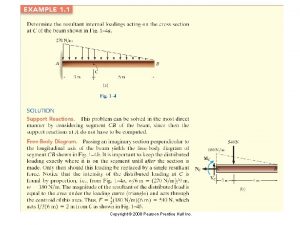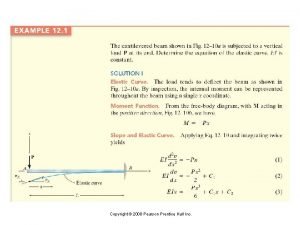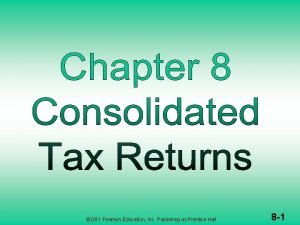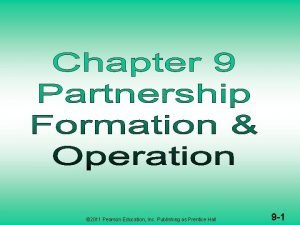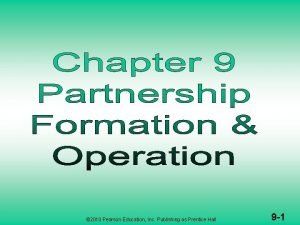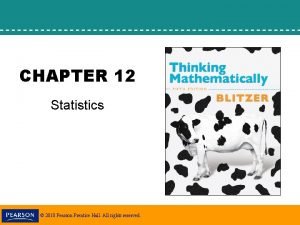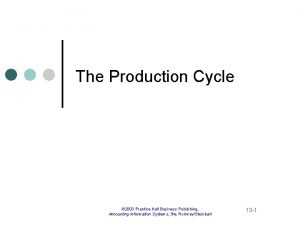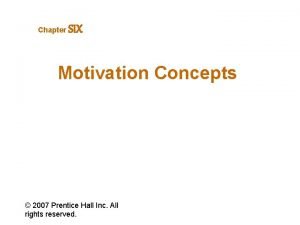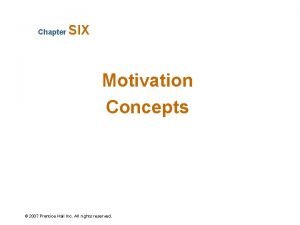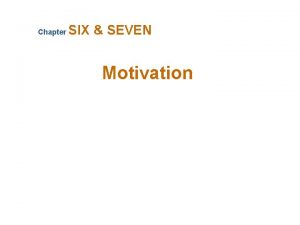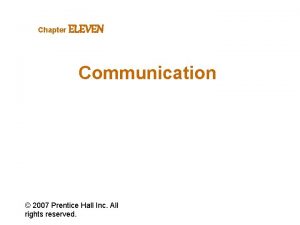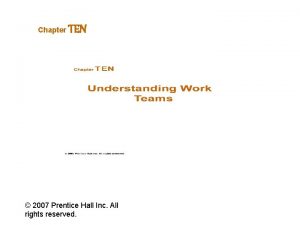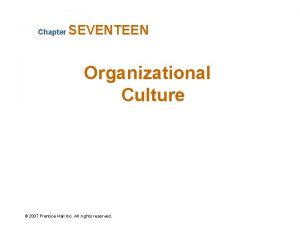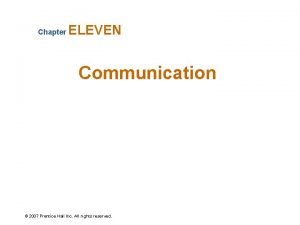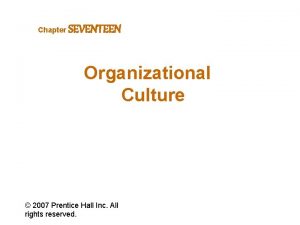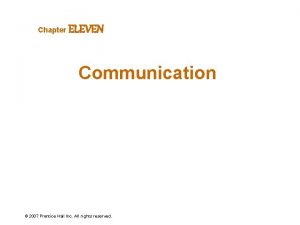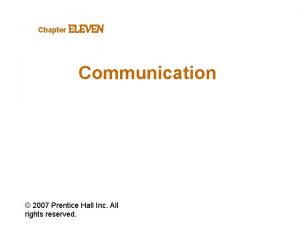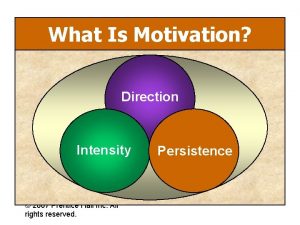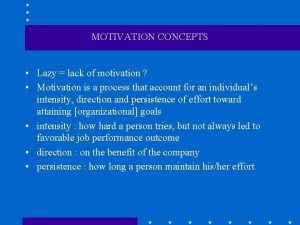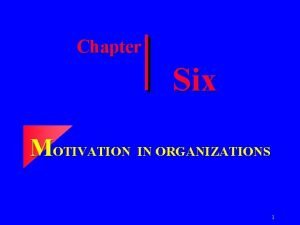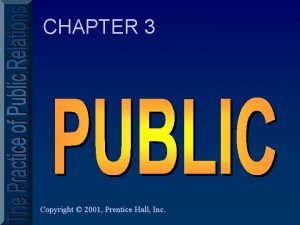Chapter SIX Motivation Concepts 2007 Prentice Hall Inc

























- Slides: 25

Chapter SIX Motivation Concepts © 2007 Prentice Hall Inc. All rights reserved.

What Is Motivation? Direction Intensity Persistence

What is Motivation? Motivation The processes that account for an individual’s intensity, direction, and persistence of effort toward attaining a goal. Key Elements 1. Intensity: how hard a person tries 2. Direction: toward beneficial goal 3. Persistence: how long a person tries © 2007 Prentice Hall Inc. All rights reserved.

Maslow’s Hierarchy of Needs Lower-Order Needs Higher-Order Needs that are satisfied externally; physiological and safety needs. Needs that are satisfied internally; social, esteem, and self-actualization needs. Self Esteem Social Safety Physiological E X H I B I T 6– 1 © 2007 Prentice Hall Inc. All rights reserved.

Assumptions of Maslow’s Hierarchy Movement up the Pyramid • Individuals cannot move to the next higher level until all needs at the current (lower) level are satisfied. • Individuals therefore must move up the hierarchy in order Maslow Application: A homeless person will not be motivated to meditate! © 2007 Prentice Hall Inc. All rights reserved.

Having Little Ambition Theory X Managers See Workers As… Disliking Work Avoiding Responsibility Self-Directed Theory Y Managers See Workers As… Enjoying Work Accepting Responsibility

Herzberg’s Two-Factor Theory Bottom Line: Satisfaction and Dissatisfaction are not Opposite Ends of the Same Thing! Hygiene Factors: • Salary • Work Conditions Separate constructs – Hygiene Factors--Extrinsic & Related to • Company Policies © 2007 Prentice Hall Inc. All rights reserved. Dissatisfaction Motivators: • Achievement • Responsibility • Growth – Motivation Factors--Intrinsic and Related to Satisfaction

Comparison of Satisfiers and Dissatisfiers Factors characterizing events on the job that led to extreme job dissatisfaction Source: Reprinted by permission of Harvard Business Review. An exhibit from One More Time: How Do You Motivate Employees? by Frederick Herzberg, September–October 1987. Copyright © 1987 by the President and Fellows of Harvard College: All rights reserved. © 2007 Prentice Hall Inc. All rights reserved. Factors characterizing events on the job that led to extreme job satisfaction E X H I B I T 6– 2

Contrasting Views of Satisfaction and Dissatisfaction E X H I B I T 6– 3 © 2007 Prentice Hall Inc. All rights reserved.

David Mc. Clelland’s Theory of Needs Need for Achievement Need for Affiliation The drive to excel, to achieve in relation to a set of standards, to strive to succeed. The desire for friendly and close personal relationships. Need for Power The need to make others behave in a way that they would not have behaved otherwise. © 2007 Prentice Hall Inc. All rights reserved. Bottom Line: Individuals have different levels of needs in each of these areas, and those levels will drive their behavior

Cognitive Evaluation Theory Providing an extrinsic reward for behavior that had been previously only intrinsically rewarding tends to decrease the overall level of motivation. The theory may only be relevant to jobs that are neither extremely Hint: For this theory, dull nor extremely interesting. think about how fun it is to read in the summer, but once reading is assigned to you for a grade, you don’t want to do it! © 2007 Prentice Hall Inc. All rights reserved.

Goal-Setting Theory (Edwin Locke) Basic Premise: That specific and difficult goals, with self-generated feedback, lead to higher performance. But, the relationship between goals and performance will depend on • goal commitment –“I want to do it & I can do it” • task characteristics (simple, well-learned) • national culture © 2007 Prentice Hall Inc. All rights reserved.

Goal Setting in Action: MBO Programs Management By Objectives Programs • Company wide goals & objectives • Goals aligned at all levels • Based on Goal Setting Theory © 2007 Prentice Hall Inc. All rights reserved.

What is MBO? Management by Objectives (MBO) A program that encompasses specific goals, participatively set, for an explicit time period, with feedback on goal progress. Key Elements 1. Goal specificity 2. Participative decision making 3. An explicit time period 4. Performance feedback © 2007 Prentice Hall Inc. All rights reserved.

Why MBOs Fail Ø Unrealistic expectations about MBO results Ø Lack of commitment by top management Ø Failure to allocate reward properly Ø Cultural incompatibilities © 2007 Prentice Hall Inc. All rights reserved.

Self-Efficacy • An individual’s feeling that s/he can complete a task (e. g. “I know I can!”) • Enhances probability that goals will be achieved Not to be confused with: Self Esteem, which is…. Individuals’ degree of liking or disliking themselves. © 2007 Prentice Hall Inc. All rights reserved.

Self-Efficacy and Goal Setting © 2007 Prentice Hall Inc. All rights reserved.

Four Ways of Increasing Self Efficacy (Bandura) 1. Enactive Mastery 2. Vicarious Modeling 3. Verbal Persuasion 4. Arousal Note: Basic Premise/Mechanism of Pygmalion and Galatea Effects © 2007 Prentice Hall Inc. All rights reserved.

Reinforcement Theory Argues that behavior is a function of its consequences. Assumptions: • Behavior is environmentally caused. • Behavior can be modified (reinforced) by providing (controlling) consequences. • Reinforced behavior tends to be repeated. © 2007 Prentice Hall Inc. All rights reserved.

Equity Theory Individuals compare their job inputs and outcomes with those of others and then respond to eliminate any inequities. Referent Comparisons: Self-inside Self-outside Other-inside Other-outside © 2007 Prentice Hall Inc. All rights reserved.

Equity Theory (cont’d) E X H I B I T 6– 8 © 2007 Prentice Hall Inc. All rights reserved.

Justice and Equity Theory © 2007 Prentice Hall Inc. All rights reserved.

Three types of Justice Distributive Justice Procedural Justice Perceived fairness of the outcome (the final distribution). The perceived fairness of the process used to determine the outcome (the final distribution). “How was who gets what decided? ” “Who got what? ” Interactional Justice The degree to which one is treated with dignity and respect. “Was I treated well? ” © 2007 Prentice Hall Inc. All rights reserved.

Expectancy Theory Ethical Values and Behaviors of Leaders Bottom line • All three links between the boxes must be intact or motivation will not occur. Thus, • • • Individuals must feel that if they try, they can perform And If they perform, they will be rewarded And When they are rewarded, the reward will be something they care about © 2007 Prentice Hall Inc. All rights reserved.

Putting It All Together © 2007 Prentice Hall Inc. All rights reserved.
 Prentice hall physical science concepts in action
Prentice hall physical science concepts in action Pearson education inc publishing as pearson prentice hall
Pearson education inc publishing as pearson prentice hall Prentice hall inc
Prentice hall inc 2008 pearson prentice hall inc
2008 pearson prentice hall inc 2005 pearson prentice hall inc
2005 pearson prentice hall inc Prentice hall inc
Prentice hall inc Pearson education 2011
Pearson education 2011 Pearson education 2011
Pearson education 2011 2005 pearson prentice hall inc
2005 pearson prentice hall inc Pearson education inc publishing as pearson prentice hall
Pearson education inc publishing as pearson prentice hall Pearson education inc. publishing as prentice hall
Pearson education inc. publishing as prentice hall Pearson education inc. publishing as prentice hall
Pearson education inc. publishing as prentice hall Pearson education inc publishing as pearson prentice hall
Pearson education inc publishing as pearson prentice hall Pearson education inc. publishing as prentice hall
Pearson education inc. publishing as prentice hall 2011 pearson education inc
2011 pearson education inc Pearson education inc. publishing as prentice hall
Pearson education inc. publishing as prentice hall Pearson education inc. publishing as prentice hall
Pearson education inc. publishing as prentice hall Pearson prentice hall
Pearson prentice hall Prentice hall careers
Prentice hall careers Prentice hall america pathways to the present
Prentice hall america pathways to the present Prentice hall publishing
Prentice hall publishing Prentice hall african american history
Prentice hall african american history Pearson prentice hall
Pearson prentice hall Pearson prentice hall
Pearson prentice hall Common name of arthropoda
Common name of arthropoda Prentice hall business publishing
Prentice hall business publishing


